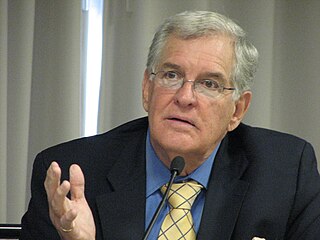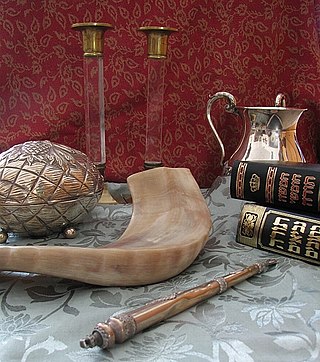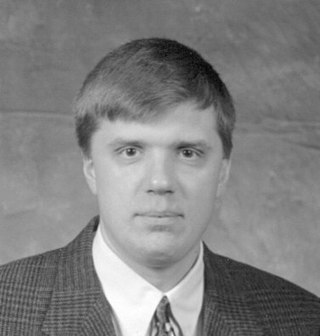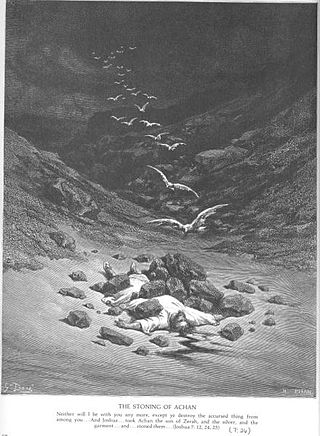Related Research Articles

Metatron, or Matatron, is an angel in Judaism, Christianity, and Islam mentioned three times in the Talmud, in a few brief passages in the Aggadah, and in mystical Kabbalistic texts within Rabbinic literature. The figure forms one of the traces for the presence of dualist proclivities in the otherwise monotheistic visions of both the Tanakh and later Christian doctrine. In the Jewish kabbalistic tradition, he is sometimes portrayed as serving as the celestial scribe. The name Metatron is not mentioned in the Torah or the Bible, and how the name originated is a matter of debate. In Islamic tradition, he is also known as Mīṭaṭrūn, the angel of the veil.

Apocalyptic literature is a genre of prophetical writing that developed in post-Exilic Jewish culture and was popular among millennialist early Christians. Apocalypse is a Greek word meaning "revelation", "an unveiling or unfolding of things not previously known and which could not be known apart from the unveiling".

The Apocalypse of Peter, also called the Revelation of Peter, is an early Christian text of the 2nd century and a work of apocalyptic literature. It is not included in the standard canon of the New Testament, but is classed as part of New Testament apocrypha. The Apocalypse of Peter is mentioned in the Muratorian fragment, a 2nd-century list list of books thought to be canonical in Christianity. The Muratorian fragment expresses some hesitation on the work, saying that some authorities would not have it read in church. The text is extant in two incomplete versions based on a lost Koine Greek original: an edited Greek version and an Ethiopic version, which diverge considerably. It is influenced by both Jewish apocalyptic literature and Hellenistic philosophy from Greek culture. The Apocalypse of Peter is the earliest-written extant document depicting a Christian version of heaven and hell in detail.
The Second Book of Enoch is a pseudepigraphic text in the apocalyptic genre. It describes the ascent of the patriarch Enoch, ancestor of Noah, through ten heavens of an Earth-centered cosmos. The Slavonic edition and translation of 2 Enoch is of Christian origin in the 8th century but is based on an earlier work. 2 Enoch is distinct from the Book of Enoch, known as 1 Enoch, and there is also an unrelated 3 Enoch, although none of the three books are considered canonical scripture by the majority of Jewish or Christian bodies. The numbering of these texts has been applied by scholars to distinguish each from the others.

Paula Fredriksen is an American historian and scholar of early Christianity. She held the position of William Goodwin Aurelio Professor of Scripture at Boston University from 1990 to 2010. Now emerita, she has been distinguished visiting professor in the Department of Comparative Religion at the Hebrew University of Jerusalem, since 2009.

Peter Schäfer is a prolific German scholar of ancient religious studies, who has made contributions to the field of ancient Judaism and early Christianity through monographs, co-edited volumes, numerous articles, and his trademark synoptic editions. He was a Professor of Religion and the Ronald O. Perelman Professor of Judaic Studies at Princeton University from 1998 to 2013.
The Third Book of Enoch, also known as The Book of the Palaces, The Book of Rabbi Ishmael the High Priest and The Elevation of Metatron, and abbreviated as 3 Enoch) is a Jewish apocryphal book.
Harold William Attridge is an American New Testament scholar and historian of Christianity known for his work in New Testament exegesis, especially the Epistle to the Hebrews, the study of Hellenistic Judaism, and the history of early Christianity. He is a Sterling Professor of Divinity at Yale University, where he served as Dean of the Divinity School from 2002 to 2012, the first Roman Catholic to head that historically Protestant school.

James Hamilton Charlesworth is an American academic who served as the George L. Collord Professor of New Testament Language and Literature until January 17, 2019, and Director of the Dead Sea Scrolls Project at the Princeton Theological Seminary. His research interests include the Apocrypha and Pseudepigrapha of the Hebrew and Christian Bibles, the Dead Sea Scrolls, Josephus, the Historical Jesus, the Gospel of John, and the Book of Revelation.
In Jewish eschatology Mashiach ben Yoseph or Messiah ben Joseph, also known as Mashiach bar/ben Ephraim, is a Jewish messiah from the tribe of Ephraim and a descendant of Joseph. The figure's origins are much debated. Some regard it as a rabbinic invention, but others defend the view that its origins are in the Torah.

Rachel Elior is an Israeli professor of Jewish philosophy at the Hebrew University of Jerusalem in Jerusalem, Israel. Her principal subjects of research has been Hasidism and the history of early Jewish mysticism.

Sefer Zerubavel, also called the Book of Zerubbabel or the Apocalypse of Zerubbabel, is a medieval Hebrew-language apocalypse written at the beginning of the seventh century CE in the style of biblical visions placed into the mouth of Zerubbabel, the last descendant of the Davidic line to take a prominent part in Israel's history, who laid the foundation of the Second Temple in the sixth century BCE. The enigmatic postexilic biblical leader receives a revelatory vision outlining personalities and events associated with the restoration of Israel, the End of Days, and the establishment of the Third Temple.

The origins of Judaism lie in Bronze Age polytheistic Canaanite religion. Judaism also syncretized elements of other Semitic religions such as Babylonian religion, which is reflected in the early prophetic books of the Hebrew Bible.
Loren T. Stuckenbruck is a historian of early Christianity and Second Temple Judaism, currently professor of New Testament at the University of Munich, in Germany. His work has exerted a significant impact on the field.

Andrei A. Orlov is an American professor of Judaism and Christianity in Antiquity at Marquette University. He "is a specialist in Jewish Apocalypticism and Mysticism, Second Temple Judaism, and Old Testament Pseudepigrapha. Within the field of Second Temple Jewish apocalyptic literature, Orlov is considered among the leading experts in the field of Slavonic texts related to Jewish mysticism and Enochic traditions." He "has established himself as a significant voice in the study of Second Temple Jewish traditions, especially those associated with 2 Enoch and other Slavonic Pseudepigrapha." Orlov is a veteran of the Enoch seminar and a member of the Advisory Board of the journal Henoch.

Herem or cherem, as used in the Tanakh, means something given over to the Lord, or under a ban, and sometimes refers to things or persons to be utterly destroyed. The term has been explained in different and sometimes conflicting ways by different scholars. It has been defined as "a mode of secluding, and rendering harmless, anything imperilling the religious life of the nation", or "the total destruction of the enemy and his goods at the conclusion of a campaign", or "uncompromising consecration of property and dedication of the property to God without possibility of recall or redemption". It is translated into Latin as devotio, a word used for human sacrifice, and into Greek as anathema, which was a sacrifice to the gods.
In rabbinic Jewish eschatology, the Righteous Priest or Priest of Righteousness is a figure identified with one of the Four Craftsmen in a vision mentioned in the Book of Zechariah. He is found in the Talmud and Midrash.
Matthias Henze is the Isla Carroll and Perry E. Turner Professor of Hebrew Bible and Early Judaism at Rice University in Houston, Texas.
Annette Yoshiko Reed is an American religious historian. She is currently a professor in the Skirball Department of Hebrew and Judaic Studies and Department of Religious Studies at New York University. Reed's research interests span the topics of Second Temple Judaism, early Christianity, and Jewish/Christian relations in Late Antiquity, with particular attention to retheorizing religion, identity, difference, and forgetting. She is the daughter of political scientist Steven Reed.
Catherine Hezser is Professor of Jewish Studies at the School of Oriental and African Studies, University of London. She specialises in rabbinic Judaism, the early history of Judaism in the Near Middle East, and the social history of the Jews in Roman Palestine during late antiquity.
References
- ↑ George, Robert P. (November 23, 2011). "Keeping Faith: Martha Himmelfarb". The Daily Princetonian . Archived from the original on December 31, 2011.
- 1 2 3 "Martha Himmelfarb: Office of the Dean of the Faculty". Princeton University. Retrieved March 24, 2024.
- 1 2 Boustan, Ra'anan; Frankfurter, David; Reed, Annette Yoshiko (2023). "Tours by the Light of Martha Himmelfarb". In Boustan, Ra'anan; Frankfurter, David; Reed, Annette Yoshiko (eds.). Above, Below, Before, and After: Studies in Judaism and Christianity in Conversation with Martha Himmelfarb. Texts and Studies in Ancient Judaism 188. Mohr Siebeck. pp. 1–12. doi:10.1628/978-3-16-163192-4. ISBN 978-3-16-163192-4.
- ↑ "Martha Himmelfarb". John Simon Guggenheim Memorial Foundation. Retrieved March 24, 2024.
- ↑ "Martha Himmelfarb and Simon Morrison receive Behrman Award for the humanities". Princeton University. May 9, 2022. Retrieved March 24, 2024.
- ↑ "Abigail Weiss, Samuel Lipson". The New York Times. August 30, 2015.